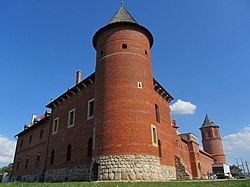
Sigismund II Augustus was King of Poland and Grand Duke of Lithuania, the son of Sigismund I the Old, whom Sigismund II succeeded in 1548. He was the first ruler of the Polish–Lithuanian Commonwealth and the last male monarch from the Jagiellonian dynasty.

Tykocin is a small town in north-eastern Poland, with 2,010 inhabitants (2012), located on the Narew river, in Białystok County in the Podlaskie Voivodeship. It is one of the oldest towns in the region, with its historic center designated a Historic Monument of Poland.

The House of Radziwiłł is a powerful magnate family originating from the Grand Duchy of Lithuania and later also prominent in the Crown of the Kingdom of Poland.

Barbara Radziwiłł was Queen of Poland and Grand Duchess of Lithuania as consort of Sigismund II Augustus, the last male monarch of the Jagiellon dynasty. Barbara, a great beauty and already widowed, became a royal mistress most likely in 1543 and they married in secret in July or August 1547. The marriage caused a scandal; it was vehemently opposed by Polish nobles, including Queen mother Bona Sforza. Sigismund Augustus, assisted by Barbara's cousin Mikołaj "the Black" Radziwiłł and brother Mikołaj "the Red" Radziwiłł, worked tirelessly to gain recognition of their marriage and to crown Barbara as Queen of Poland. They succeeded and Barbara's coronation was held on 7 December 1550 at Wawel Cathedral. However, her health was already failing and she died just five months later. Even though it was brief, her reign propelled the Radziwiłł family to new heights of political power and influence.

Trakai Voivodeship, Trakai Palatinate, or Troki Voivodeship, was a unit of administrative division and local government in the Grand Duchy of Lithuania from 1413 until 1795.

Prince Janusz Radziwiłł, also known as Janusz the Second or Janusz the Younger was a noble and magnate in the Polish–Lithuanian Commonwealth. Throughout his life he occupied a number of posts in the state administration, including that of Court Chamberlain of Lithuania, Field Hetman of Lithuania and Grand Hetman of Lithuania. He was also a voivode of Vilna Voivodeship, as well as a starost of Samogitia, Kamieniec, Kazimierz and Sejwy. He was a protector of the Protestant religion in Lithuania and sponsor of many Protestant schools and churches.
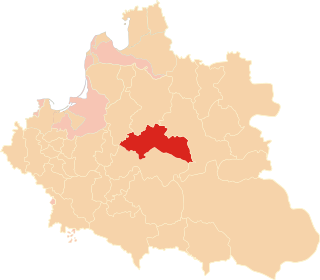
Nowogródek Voivodeship was a voivodeship of the Grand Duchy of Lithuania from 1507 to 1795, with the capital in the town of Nowogródek. Since 1569 it was located in the Polish–Lithuanian Commonwealth, as part of Lithuania.

Anna Jagiellon was Queen of Poland and Grand Duchess of Lithuania from 1575 to 1587.

The Wawel Royal Castle and the Wawel Hill on which it sits constitute the most historically and culturally significant site in Poland. A fortified residency on the Vistula River in Kraków, it was established on the orders of King Casimir III the Great and enlarged over the centuries into a number of structures around an Italian-styled courtyard. It represents nearly all European architectural styles of the Medieval, Renaissance and Baroque periods.
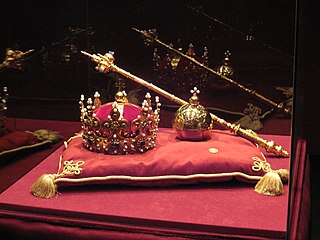
The only surviving original piece of the Polish crown jewels from the time of the Piast dynasty is the ceremonial sword Szczerbiec. It is currently on display along with other preserved royal items at the Wawel Royal Castle Museum in Kraków.

Paweł Holszański was a notable Catholic church official and one of the last male scions of the once-mighty Lithuanian Alšėniškiai princely family of the Grand Duchy of Lithuania.
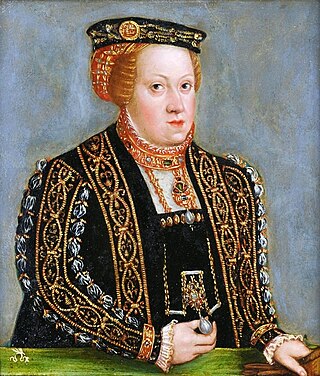
Catherine of Austria was one of the fifteen children of Ferdinand I, Holy Roman Emperor and Anna of Bohemia and Hungary. In 1553, she married Polish King Sigismund II Augustus and became Queen consort of Poland and Grand Duchess consort of Lithuania. Their marriage was not happy and they had no children together. After a likely miscarriage in 1554 and a bout of illness in 1558, Sigismund became increasingly distant. He tried but failed to obtain a divorce from the pope. In 1565, Catherine returned to Austria and lived in Linz until her death. Sigismund died just a few months after her, bringing the male line of the Jagiellon dynasty to its end. The dynasty would continue, strictly speaking, for one more reign—that of Sigismund Augustus’ sister, Anna Jagiellon, who was crowned with the male title of Rex Poloniae.

Stanislovas Goštautas was a member of the Lithuanian nobility and a high-ranking member of the Lithuanian administration. Born to Albertas Goštautas, the Voivode of Vilnius and Princess Sofia of Vereya, he was the last direct male descendant of the – once mighty – Goštautai family.

The Polish–Swedish War of 1621 to 1625 was a war in a long-running series of conflicts between the Polish–Lithuanian Commonwealth and the Swedish Empire. It began with a Swedish invasion of the Polish–Lithuanian fiefdom Livonia. Swedish forces succeeded in taking the city of Riga after a siege. The Commonwealth, focussed on war with the Ottoman Empire, was unable to send significant forces to stop Gustav Adolf, and signed a truce favorable to Sweden. The Commonwealth ceded Livonia north of the Dvina (Düna) river, and retained only nominal control over Riga. The new truce in Mitau was signed and lasted from November 1622 to March 1625.

The mass murders in Tykocin occurred on 25 August 1941, during World War II, where the local Jewish population of Tykocin (Poland) was killed by German Einsatzkommando.
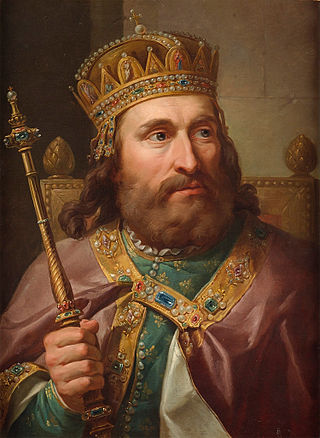
The Hungarian Crown was a part of the Polish Crown Jewels. It was made in the 16th century, resembling the Crown of Saint Stephen, as a private crown of John II Sigismund Zápolya.

The Jagiellonian tapestries, are a collection of tapestries woven in the Netherlands and Flanders, which originally consisted of 365 pieces assembled by the Jagiellons to decorate the interiors of the royal Wawel Castle in Kraków, Poland. The collection is also collectively known as the Wawel Arrasses, as the majority of the preserved fabrics are in the possession of the Wawel Castle Museum and the French city of Arras, which was once a manufacturing centre of this kind of wall decoration in the beginning of the 16th century. The works became state property of the Crown of the Kingdom of Poland according to the will of Sigismund II Augustus.
Throughout its early history, the area comprising the current day Podlaskie Voivodeship was inhabited by various tribes of different ethnic roots. In the 9th and 10th centuries, the area was likely inhabited by Lechitic tribes in the south, Baltic (Yotvingian) tribes in the north, and Ruthenian tribes in the east. Between the 10th and 13th centuries, the area was part of the Ruthenian principalities. The area became a part of the Medieval Slavic cities union of Cherven cities. Until the 14th century the area was part of pro-Kyivan Ruthenian states, and was later annexed by the Grand Duchy of Lithuania. In 1569, after the Union of Lublin, the western part of Podlaskie was ceded to the Kingdom of Poland.

The Jagiellonian or Jagellonian dynasty, otherwise the Jagiellon dynasty, the House of Jagiellon, or simply the Jagiellons, was the name assumed by a cadet branch of the Lithuanian ducal dynasty of Gediminids upon reception by Jogaila, the Grand Duke of Lithuania, of baptism as Władysław in 1386, which paved the way to his ensuing marriage to the Queen Regnant Jadwiga of Poland, resulting in his ascension to the Crown of the Kingdom of Poland as Władysław II Jagiełło, and the effective promotion of his branch to a royal dynasty. The Jagiellons reigned in several European countries between the 14th and 16th centuries. Members of the dynasty were Kings of Poland (1386–1572), Grand Dukes of Lithuania, Kings of Hungary, and Kings of Bohemia and imperial electors (1471–1526).
The Battle of Tykocin took place on 13 July 1656 and was one of battle of the Swedish invasion of Poland. It resulted in a victory of Sweden and Brandenburg forces, commanded by Duke Boguslaw Radziwill, and ended siege of Tykocin.
